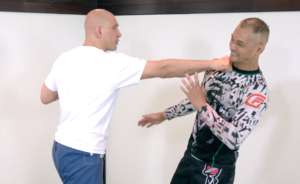In your regular training you may practice all kinds of cool blocks and counters to punches, but what about defending against the punch that you don’t see coming? The sucker punch! That’s a really tricky, and very scary situation.
But there are certain precautions and techniques you can use to minimise the danger from this cowardly ambush scenario.
In fact, here are 5 steps to defending against a sucker punch attack.
Steps 1 and 2 focus on learning some of the most common sucker punch attacks. If you know the tricks that people are going try on you then you’ll be much more likely to recognise when this is about to happen.
Steps 3, 4 and 5 in the second half of this article cover some simple responses to keep you safe(er) if someone is actually swinging at you.
No more chit-chat! Let’s get started so you can stay safer faster!
Steps 1 and 2: Sucker Punch Awareness
OK, let’s first cover two of the most common sucker punch setups so you don’t get caught unawares.
Here’s a 4:25 video that covers these two attacks, or you can scroll down and get the information in written form…
Step 1: Recognising the “Distract and Blindside” Sucker Punch
One very common way to sucker punch someone is to have an accomplice distract your target while you sneak around and blindside your victim. (We discussed this tactic more fully in a recent article called “Avoiding the Street Ambush” that you can read on this site.)
If you’re the intended victim then one attacker gets in your face and engages your attention. He might be asking for directions in a friendly way, or he might be confrontational… it doesn’t matter. His goal is to distract you so you don’t notice his accomplice sneaking around to your blindside.
Once the other guy is behind you then you’re really in danger. He can club you in the head, or simply haul off and slug you in the the jaw or the temple, both of which are great targets to knock someone out.
The point here is to maintain continuous 360 degree vigilance and prevent a potential attacker from getting into your blindspot.
The distract and blindside is a multiple attacker sucker punch tactic. Now let’s look at a very common trick used by single attackers to try and land a sucker punch on your jaw…
Step 2: Recognising the “Fadeaway” Sucker Punch
If someone is in your face, yelling and screaming, then of course you’re on alert. The dude is upset and you’re watching his hands, monitoring distance, and doing all the right things to make sure you’re not giving him an easy target.
But what if seems to concede, shakes his head, and begins to turn away? Have you just won the argument, or is he setting you up for a gigantic overhand right?
It’s tough to tell, so don’t relax your guard just yet!
By turning away he puts you at ease and causes you to let your guard down. But if his intentions are malicious it also allows him to wind up for that big giant punch, which, most of the time, will be with his right hand.
The motion here is similar to how a boxer throws an overhand right…
Someone throwing the overhand right rear hand will often drop his rear hand down so it disappears behind his body. Once his fist is hidden from view it accelerates down, back and up until it reappears above his head going a million miles an hour towards your face.
Similarly, the fadeaway sucker punch uses uses the body of the attacker to obscure the initial preparations for the punch, and by the time you notice that it’s en route it may be too late.
So just because someone turns away from you don’t let your guard down! You’re not out of the woods quite yet…
Bottom line: if someone begins to de-escalate a confrontation or starts to disengage that’s a good sign, but definitely don’t relax until there’s a TON of distance between you.
By there way, a closely related attack is one in which an aggressive person suddenly becomes very friendly. Maybe the two of you were shouting at each other a minute ago, but now he’s offering to buy you a beer.
What’s going on? Has he seen the light and decided that he’d rather not fight? That could be the case, but maybe he’s just trying to put you at ease before sucker punching you.
Steps 3, 4 and 5: Sucker Punch Survival
OK, so the most important part of surviving a sucker punch is awareness and not getting tricked by any of the tactics that we covered above.
Let’s say that your awareness is high and you’re pretty sure that the attack is likely is coming: what do you do?
Well, here’s a 4:55 video that I shot of you that covers three good options to surviving a sucker punch that’s about to rearrange your face…
A Side Note About Preemptive Strikes…
If you’re 100% sure that a fight is going to go down then there is an argument for a preemptive strike that starts the fight on your terms rather than requiring you to react to your opponent.
But we have to acknowledge that preemptive strikes can be very dangerous… for you!
Even if you ‘just’ knock them out with a punch to the head and they fall, split their skull open and die then you can go to jail for it for decades. This is a real danger and this happens all the time.
Talk about winning the battle but losing the war!
So only punch first in the direst of situations. It’s much, much better to move away, increasing the distance between the two of you so you have more time to react (without turning your back on your adversary of course!).
And if you can’t move away, if you have to stay in the pocket, then you’re much safer legally controlling someone with grappling (using the arm drag and rear naked choke, for example) than you are with a knockout attempt. Plus your knuckles won’t hurt so much afterwards!
Step 3: Awareness of Range (the ‘One Punch Plus One Step’ rule).
If you’re within arm’s length of your opponent then he can punch you without taking a step. And at that close range reacting in time to prevent the punch is much more difficult.
So you can either spend years and years training hoping to increase your reaction speed to Floyd Mayweather levels, OR you can simply take a step back and increase the distance between you and your potential attacker.
Ideally you want to stay at least the distance of one outstretched punch plus one additional step away.
This way he can’t just punch you. He has to take an extra step too. That means at least two things: first of all, covering distance takes time, and you can use that time to get your defences ready. And secondly that step it gives you an easy cue you can react to: if he takes a step towards you then get ready, it’s about to get real!
The trouble here is that you can’t maintain your no-man’s land perimeter around you at all hours of the day and night. In society there are some situations, like the lineup at a Starbucks or when you’re standing between someone and your kids, where you simply have to let people get close to you.
So if you can’t make more space then what you can you do? The answer is to keep your hands up! But as you’ll see in the next step, this can be a little more complicated than you might think.
Step 4: Hands Up Non-Aggressively
If your hands are down by your waist and someone throws a punch at your face then there’s almost no way you’ll be able to get your hands up in time.
It’s like a drag race where one car can start whenever it wants to but the second car has wait until the first car goes. By the time the driver of the second car notices that the first car is moving and hits the accelerator it’s too late. Too much time has elapsed, too much speed has been gained, and it’s now almost impossible for the second car to catch up.
So clearly you’re in a MUCH better position if you can start with your hands already up.
Trouble is, if you get into an aggressive boxing posture then you’re essentially guaranteeing a confrontation. Plus you’re telling your opponent that you’re trained, which may be something that you want him to find out the hard way.
So save the full-on combat stance for when the punches actually start flying!
Generally it’s a better idea to adopt a non-confrontational stance that keeps your hands up so they can be brought into play rapidly without signalling an aggressive intent.
In the post from the Self Defense Tutorials Instagram feed below you’ll see four different options. Clockwise from the upper left they are…
- A boxing stance with the fists up and the chin down (clearly an aggressive pose )
- A pensive pose, with one hand cupping the chin and the other hand over the ribs or the solar plexus (I was first taught this by my Kajukenbo coach Philip Gelinas)
- Both hands up and open. I like both hands pointing outwards; if the palms are down like in a pseudo Muay Thai stance then it looks much more threatening and may not have the deescalatory effect you might want.
- Both hands up but palms turned towards your own body. This is very non-threatening because it looks like you’re hugging yourself out of fear, but of course you’re ready to go. This posture was advocated by my friend Chad, a bouncer I interviewed in this episode of Tales from the Door.
Step 5: Step INTO the Danger When It Comes
If a punch is speeding towards your face and you do nothing then – BOOM – it’s going to land hard.
Moving backwards isn’t ideal because your opponent can run faster forwards than you can backpedal and so he’ll eventually run you over, but at least the weapon (his fist) and the target (your face) are moving in the same direction which means that the impact will be somewhat less.
But moving towards your opponent is better yet.
You can accomplish this by ‘putting on the helmet’ like we covered in the surviving strikes from the mount article, level changing and shooting in, going for the Thai clinch, or many other methods.
By moving forwards you’re hopefully getting inside the arc of his strike, establishing controls, and preventing followup strikes.
Hopefully you found this information useful, and hopefully it keeps you safer against the sucker punch.
Here at Self Defense Tutorials we’re putting out new tips, techniques, videos and articles all the time, and the best way to stay up to date is with our Self Defense Tips email newsletter.
This newsletter is 100% free, and if you ever stop liking what we send you then you can easily and permanently unsubscribe from all future emails with a single click by following the ‘manage your subscription’ link at the bottom of every email we’ll ever send you.
Enter your best email in the form below to sign up and at least check out the materials that we’re going to send you.
Get My FREE Self Defense Tips by Email

